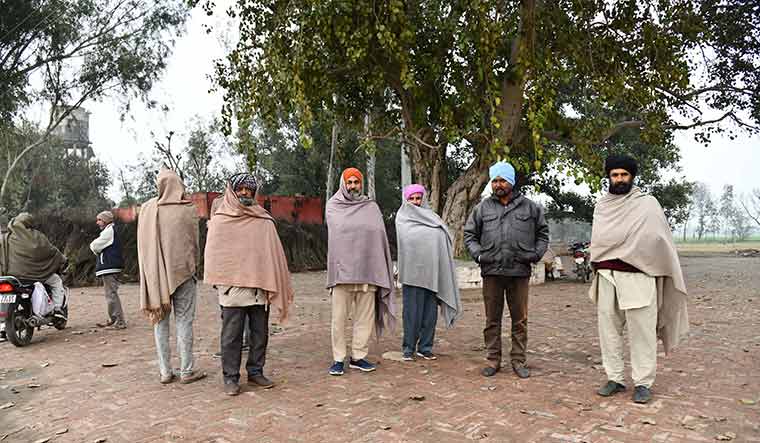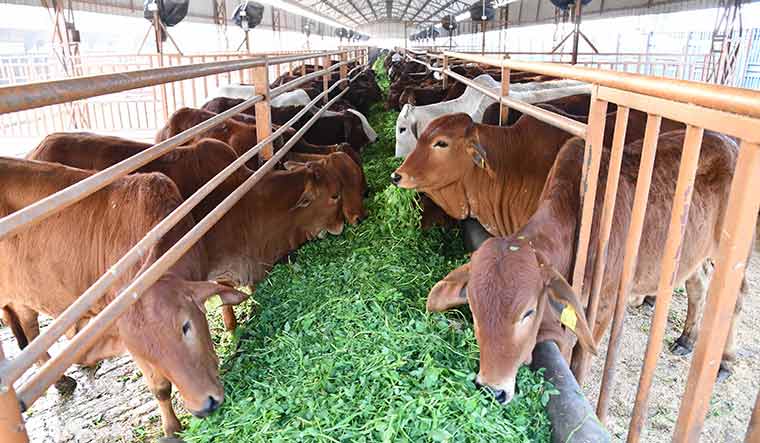Sant Niranjan Das looks benignly at his devotees. The 81-year-old is the head of Dera Sachkhand, Ballan, one of the largest religious centres in the Jalandhar region. He occasionally lends his ear to those who seek his counsel, but says little. Armed police personnel in the dera premises keep a watchful eye, and hymn singers recite verses of Guru Ravidass, a 14th-century mystic and social reformer. “You should partake of food from langar (community kitchen) first,” he says, as his aide introduces us to the seer. On the previous day, Punjab Chief Minister Charanjit Singh Channi had spent the night at the dera, which draws its followers prominently from the dalit community. The chief minister chose to sleep on the floor of Sant Niranjan Das’s room.
The followers of Guru Ravidass’s teachings are known by the name Ravidassias. The Election Commission (EC) had postponed the assembly polls in the state by one week, so that the Ravidassias could go to Varanasi to attend the Guru Ravidass Jayanti celebrations on February 16. It was primarily on Channi’s insistence that the EC had taken this decision. Every year, the Ravidassias board a special train, Begumpura Express, for Varanasi for the Jayanti. Sant Niranjan Das’s guru, Sant Sarwan Das, built the pilgrim centre at Seer Goverdhanpur—the birthplace of Guru Ravidass in Varanasi.
During election season, political leaders of all hues would visit Dera Sachkhand. The dera, which manages several schools and other charitable institutions, has become a symbol of dalit assertion in the state. “There are around 22 crore dalits in India,” said Sat Paul Virdi, general secretary, Shri Guru Ravidass Janam Asthan Charitable Trust. “In Punjab, over 35 per cent of the population are dalit. In Doaba region [districts of Jalandhar, Nawanshahr, Hoshiarpur and Kapurthala], our population is over 42 per cent.”
The faithful from all over the region visit the dera regularly. On special occasions, dalits from Maharashtra, Andhra Pradesh and Karnataka also come. The influence of this dera can be further understood from the fact that it declared the Ravidassia a separate religion in 2010. In 2020, it had demanded a separate column of Ravidassia in the population census.
In 2009, Sant Niranjan Das and his deputy Sant Ramanand were attacked by the Sikh radicals in a gurdwara in the Austrian capital, Vienna. Ramanand died in the attack, while Niranjan Das suffered severe injuries from gunshots. The tragic incident resulted in the community’s split from Sikhism. “We replaced the Guru Granth Sahib, the holy book of Sikhism, with Amritbani Satguru Ravidass Granth, which carried the hymns of Guru Ravidass,” said Virdi. “Now, many of the gurdwaras belonging to Ravidassias have either Amritbani or both. And, the chief of Dera Sachkhand is like the Pope for us.”
Virdi added that after becoming a separate religion, the Ravidassias actively embraced their dalit identity and started taking pride in it. Retired Army officer Major Parshotam Thind, who manages the library at Dera Sachkhand, said this has changed the community. “We grew in confidence. Our youth gained pride,” he said.
All senior leaders from different parties—including the Badals, Navjot Singh Sidhu, Captain Amarinder Singh and Arvind Kejriwal—have found time to visit Dera Sachkhand in the last few months. “Prime Minister Narendra Modi called Sant Niranjan Das when the latter had fallen sick,” Virdi recalled.
Punjab is a fertile ground for deras and sects. Helmed by living gurus, there are over 10,000 deras in the state. Some of the prominent ones apart from Dera Sachkhand include Radha Soami Satsang Beas (RSSB), Divya Jyoti Jagriti Sansthan (DJJS), Dera Sacha Sauda (DSS) and Dera Baba Mast Ram. There are also the deras of the Namdhari sect. There are many caste-based deras, too; they are often considered close to one particular party or other. The now jailed guru Gurmeet Ram Rahim’s DSS had supported the Congress and later the BJP.
Most deras, however, try to stay politically neutral, as taking sides often comes at a cost. Punjab has seen the rise of Christian deras, too, in recent years.
If Dera Sachkhand is more like a traditional gurdwara or temple, the DJJS—founded by Ashutosh Maharaj—has a modern campus spread over 300 acres in Nurmahal, Jalandhar. Maharaj was declared “clinically dead” on January 29, 2014. However, his followers believe he is in samadhi—a deep meditative state—and would return one day. For the last eight years, his body has been preserved in a freezer. Every year, doctors from the Postgraduate Institute of Medical Education and Research, Chandigarh, inspect the body for any signs of decay, as per the court order.
Hailing from Bihar, Maharaj made Punjab his home during the heights of the separatist movement. At DJJS, preachers would join first-time visitors to give an overview of the life and spirituality of Maharaj.
Pracharak Ram Niwas explained to us the various work done by the Sansthan—courses for blind, children and prisoners to programmes for promoting ayurveda and organic farming. “We even run a cattle semen bank where we have 125 high-quality bulls. Our gaushala, which has over 900 Indian breed cows, has won an award,” he said.
As Ram Niwas attended to other VIP guests, preacher Abhinavanand joined us. He gave us a 30-minute talk about the “spiritual journey” that would help in “practically experiencing and realising God”.
He is one of 10,000 preachers trained before Maharaj’s “samadhi”. “It is only when Maharaj returns from samadhi that new preachers will be ordained,” said Swami Girdharinand, who is part of the temple management at the DJJS. “Maharaj ji used to talk about samadhi and how several saints took it and returned after several years. At that time, we did not understand, but now we do. He will return.”
DJJS claims to have over 32 lakh followers—from different religions and castes—in Punjab alone; the organisation has 65 branches in the state. It has a presence in nearly 20 countries. The dera officials said several political leaders, including chief ministers, would visit the ashram during election time.
Many of these deras had faced opposition from the radical Sikhs at some point or other. Maharaj, too, faced problems following which he was provided Z-plus security. What attracts people to the deras is the community feeling they provide. Unlike traditional temples or gurdwaras, living gurus are available to people. A lot of these deras are syncretic—they mostly cater to the marginalised sections among Hindus and Sikhs. Radha Soami Satsang Beas (RSSB) is a good example. In 2016, Rahul Gandhi spent a night at the RSSB headquarters seeking support from the dera which attracts both Sikhs and Hindus alike. The Namdharis is another influential sect with a distinct identity. This community, which has made stellar contributions to classical music and sports, believes that the lineage of Sikh gurus did not end with the tenth guru, Guru Gobind Singh; they recognise a continuing line of gurus.
Dera Baba Mast Ram of Jatana Uncha village is a place where spirituality meets the spirits. This dera in Fatehgarh Sahib district distributes alcohol as prasad.
“Baba Ji [Mast Ram], who lived in a small hut before his death in 1954, was fond of alcohol,” said Manjit Singh, a volunteer at the dera. “So, devotees used to offer him liquor for their wish fulfilment. This tradition continued till recently. Baba ji used to stay naked in his hut, and covered himself only when women came seeking his blessings.” Singh looks after the current guru, who is now confined to his bed, but is open to blessing the faithful from a distance. Alcohol was banned inside the dera premises after a gurdwara was built next to it. Now, those hoping to get liquor prasad would wait patiently outside the compound of the dera.
Devotees bring new clothes and blankets also as offering at the dera. “The tradition is that we change the clothes of the idol of Baba Mast Ram every day at 4am after he is bathed with milk,” said Singh. “So, there will be a long queue of devotees who wait for their turn to offer newly stitched clothes and blankets to Baba ji.”
When asked whether politicians would come to the dera, Singh said: “Oh, they come in droves, mostly asking for victory in elections. They come here quietly to offer prayers, as the dera does not support [any] one party.”




